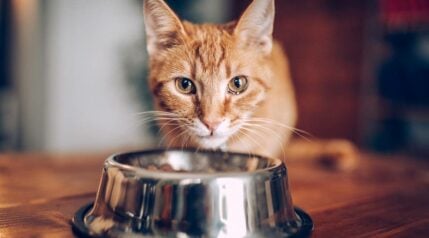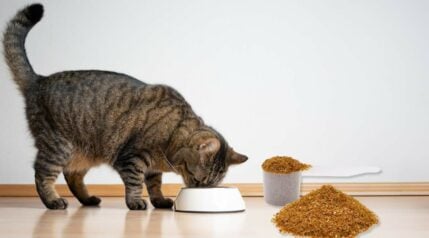When you purchase through links on our site, we may earn a commission. Here’s how it works.
Cat owners commonly have questions about what foods are safe for their felines to consume. Our kitties are inquisitive creatures and are well known for swiping a bite or two of food from our plates. Pets are often curious about what we are eating, largely because it is something other than them that we are interested in. Sometimes pet owners worry about foods that can be common, but other times felines can get into more exotic foods, like dragon fruit. This might cause owners to wonder, can cats eat dragon fruit?
It might not be something found in every kitchen, but this exotic tropical fruit has found its way to plenty of culinary dishes and recipes. The brightly colored produce catches the eye of humans and may just intrigue a curious feline when they see owners cutting one open.
Feline owners need to know what foods are safe for their purr babies to eat. We explain the details and discuss if kitties can eat the produce, if it is toxic for them, and if it has any potential health benefits. Let’s get into it and learn all about cats and eating dragon fruit.
What Is Dragon Fruit?
Dragon fruit is a distinct-looking tropical fruit native to Central America and southern Mexico. It has grown in popularity over recent decades and is able to be grown successfully all over the world. The scaly, semi-sweet produce is named after a dragon due to its unique appearance, brightly colored red to purple skin with green scales. Most varieties that we humans consume have white pulp with black seeds. There is a lesser-known variety that has red pulp and black seeds and a yellow-skinned variety.
The tropical produce looks quite exotic and might be a food that scares people away due to its odd appearance. It tastes sweet, something like a fusion of pear and kiwi. The texture of the pulp is soft, more like that of a ripened kiwi than a firm pear. The plant is a cactus known as the Hylocereus cactus or Honolulu queen. It is also called the pitaya, strawberry pear, and pitahaya.
The strawberry pear is less sweet and high in antioxidants, fiber, low sugar, and lower carbohydrates than many other tropical produce options. This plant is high in vitamin C and prebiotics and supports immune system health.
People have started to eat dragon fruit more due to its high fiber, low carb, and low sugar content. The pulp is often served by itself, in a salad with other produce, in smoothies, juices, yogurt, ice creams, cocktails, and even in some desserts. For humans, it can help lower blood sugar, boost antioxidants, support immune system health, and boost iron levels.
Can Cats Eat Dragon Fruit?
The short answer is yes. Cats can eat dragon fruit. Pitaya is not toxic to them and does not contain any poisonous compounds. While pitaya is not food that most kitties will seek out, if they eat a few bites, they will be okay. Unlike with some other fresh produce options, both the pulp and the skin, as well as leaves and stems, are considered non-toxic to felines. This food should not be in their diets regularly, but in small doses, it is not usually harmful. As with all human foods, there are risks.
Is Dragon Fruit Good For Cats?

Felines are obligate carnivores, which means that they need to get their nutrition from meat. Animal proteins are the main source of their energy. The strawberry pear has the potential for some health benefits. It can provide kitties with vitamin A, which supports eye and skin health. Fiber can be beneficial for digestive health, and other minerals like copper, iron, and zinc boost the immune system. However, the amount a cat would need to eat to see marked benefits would be far too much for them to digest safely.
High-fiber plant foods may cause some digestive upset, pain, diarrhea, nausea, and vomiting. Nothing in the fuit is toxic to them, but if they eat too much of it, they may be uncomfortable for a few days. It is hard for felines to digest, and owners should avoid giving them too much-added plant material.
While pitaya has some benefits for humans, most of those are lost on felines. The high fiber content may be helpful with digestion, and a bite or two occasionally will not likely cause much upset. However, it’s never a good idea to regularly add fresh produce to your pet’s diet. It does not provide much nutritional benefit for them. Feline’s nutritional needs are better met with high-quality cat food.
Can Dragon Fruit Hurt My Cat?
Though not considered to be toxic to felines, it should only ever be fed to them in strict moderation. It can be added in small pieces to their food as a very occasional treat. As with any human food, or food unnatural to a feline’s diet, there are some risks owners should take into consideration. The first risk is digestive pain and upset. it can come from the high fiber content of this food. If they eat too much, it could potentially cause extreme Constipation or even an intestinal blockage in severe cases.
Along with the risk of digestive upset, big pieces of food like pitaya are choking hazards for kitties. Though the pulp is soft and squishy, there are still chances of choking hazards if the pieces are too big. Because of the soft texture, cats may not chew it thoroughly, which can lead to potential choking issues.
Additionally, even though the strawberry pear has less sugar than many other choices, it still contains more than felines should be eating. The feline digestive system does not do very well breaking down plant material and sugars. If a feline eats too much sugar, they can develop long-term health issues, including obesity and diabetes.
What Should I Do If My Cat Eats Dragon Fruit?
Some felines may have an adverse reaction after eating this food. It is important that owners keep their eyes out for any behavior that seems out of character or symptoms that a kitty may be in distress. These can include a lack of appetite, lack of energy, swelling around the face or mouth, irritation in the throat, excessive drooling, nausea, vomiting, diarrhea, or bloody stool, as well as low er energy or aggression. If your cat has eaten any human food and is exhibiting signs of distress, it is best to contact your veterinarian for advice.
If you are considering adding fresh foods to your kitty’s diet because you are worried about digestive issues or they are having trouble, it is best to discuss things with your veterinarian first. They will likely want to do an exam and discuss your cat’s eating habits and bowel movements with you to determine if your cat needs to be on a special diet, as well as eliminate any underlying medical concerns.
Tasty Alternatives
While fresh produce can be a nice treat occasionally, felines do not taste sweet flavors. So, they will not likely seek out sweet-flavored things like pitaya. There are several other alternative treats that owners can offer.
Felines absolutely love the taste of meat and will go bonkers for meat-based treats. Prepared properly, owners can offer them a bit of raw meat occasionally or even consider a raw food diet. Freshly prepared meals from human-grade ingredients are a wonderful choice to provide felines top nutrition, but they also serve as a delectable treat that carries no risk like some other human foods.
Freeze-dried cat foods and treats are other fantastic options. Many of these are single protein treats and freeze-dried either raw or after freshly being cooked. They provide high levels of protein, delicious flavor, and healthy fats and are far more suited for your feline friend than fresh produce. Catnip-infused treats can be very fun as well and keep purr babies entertained for hours. You can also try tasty CBD cat treats, which can have some calming effects.
Frequently Asked Questions
Can kittens eat dragon fruit?
Although not considered toxic to felines, it is best to keep the fruit away from kittens. Kitten’s digestive systems are still developing and are not able to handle excess amounts of plant material. For kittens, it’s always best to stick to high-quality, well-balanced kitten-formulated commercial cat food. There are several varieties to choose from, including kibble, canned, soft, semi-moist, fresh, freeze-dried, and raw meals.
Is dragon fruit toxic to cats?
No, the strawberry pear is not toxic to cats. There is nothing in it that is poisonous to them, including the seeds. Though unlikely a cat would want to chew on the rind, stems, or leaves, these are not thought to be toxic either.
Can cats eat yellow, red, and purple pitaya?
Yes, kitties can eat all colors. This applies both to the skin and to the color of the flesh. Some have red flesh, some have white, and some have pink to purple.
Are there any fruits toxic to cats?
Yes, there are several kinds of produce that are incredibly harmful to felines and should be kept away from them at all times. These include all types of citrus, raisins, grapes, as well as any kind of pitted produce like cherries. Additionally, kitties should never be fed vegetables like onions, garlic, chives, leeks, shallots, wild mushrooms, or rhubarb. Nuts and seeds are also usually considered harmful and should be avoided.
Do cats like fruit like pitaya?
There is no straightforward answer to this question, some purr babies may like to eat produce, and others do not. It is something that owners need to determine on an individual basis for their pets. Felines cannot taste sweet flavors but may appreciate the fruit for a unique smell, a change in texture, or simply because they often see their owners eating it and want to get in on the fun.
Final Thoughts
Dragon fruit is an exotic tropical plant that is a member of the cactus family. These scaly, brightly colored orbs are not usually available in most supermarkets but are growing in popularity among humans for their low sugar content. While the fruit might be growing in popularity among humans, it is not something that one would expect to feed their kitty regularly. Cats can eat the strawberry pear, though it has few nutritional benefits for them and is not something that is part of a feline’s natural diet. Though not toxic, it may be hard for them to digest and may cause stomach upset and other short-term issues.
Owners should always discuss any nutritional concerns they have about their pet with their veterinarian before trying to supplement it with human foods like fresh produce.




